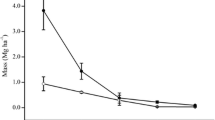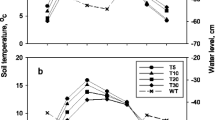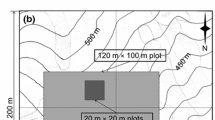Abstract
In contrast to the well-documented seasonal variation in growth of below- and above-ground components of trees, the annual variation in below- and aboveground production is not well understood. In this study, we report on the monitoring of an unmanaged hardwood forest ecosystem in a small watershed of southern Quebec between 1993 and 1999. Below- and above-ground biomass production, leaf and soil solution chemistry, and air temperature were measured at different regular intervals and are reported on an annual basis. The objective of the study was to describe the annual dynamics of carbon partitioning between below- and above-ground tree components and to gain a better understanding of the soil and climatic factors that govern it. Fine root production peaked one year earlier than woody biomass production and years with high production of fine roots had low woody biomass production. All models that included May temperature in the calculation of the predicting/independent variables were significant predictors of total tree biomass production (r > 0.87). Fine root production was associated negatively with the previous year average growing season temperature (r < -0.84). Soil solution NO3 −, NH4 + and NO3 − + NH4 + concentrations were positively correlated with fine root production (r > 0.72) and negatively correlated with woody biomass production (r < -0.84). Leaf N and P concentrations were negatively correlated (r = -0.99 and r = -0.98, respectively) with fine root production for the period of 1994–1998. Our results suggest that a cool growing season, and in particular a cool month of October, is likely to result in low fine root production and nutrient uptake the following year and, therefore, to increase soil N availability and decrease leaf N. This initial response is thought to be the first step of a feedback loop involving plant N nutrition, soil N availability, fine root growth and aboveground biomass production that led to a cyclical (3–4 years) but asynchronous production of fine roots and aboveground biomass production.
Similar content being viewed by others
References
Abrams M D, Ruffne C M and Morgan T A 1998 Tree-ring responses to drought across species and contrasting sites in the ridge and valley of Central Pennsylvania. For. Sci. 44, 550-558.
Allen S E 1989 Analysis of vegetation and other organic constituents. In Chemical Analysis of Ecological Materials. pp 160-200. Blackwell Scientific, Oxford.
Axelsson E and Axelsson B 1986 Changes in carbon allocation patterns in spruce and pine trees following irrigation and fertilization. Tree Phys. 2, 189-204.
Bartsch N 1987 Response of root systems of young Pinus sylvestris and Picea abies plants to water deficits and soil acidity. Can. J. For. Res. 17, 805-812.
Bernier B and Brazeau M 1988 Nutrient deficiency symptoms associated with sugar maple dieback and decline in the Québec Appalachians. Can. J. For. Res. 18, 762-767.
Bevington K B and Castle W S 1985 Annual root growth pattern of young citrus trees in relation to shoot growth, soil temperature, and soil water content. J. Am. Hort. Soc. 110, 840-845.
Black T A, Chen W J, Barr A G, Arain M A, Chen Z, Nesic Z, Hogg E H, Neumann H H and Yang P C 2000 Increased carbon sequestration by a boreal deciduous forest in years with a warm spring. Geophys. Res. Lett. 27, 1271-1274.
Botkin D B 1989 Manual for Jabowa-II, Version 1.1, Forest Growth Model, Santa Barbara Institute for Environmental Studies, Santa Barbara, CA. 90 pp.
Brooks J R, Flanagan L B and Ehleringer F R 1998 Responses of boreal conifers to climate fluctuations: indications from tree-ring widths and carbon isotope analyses. Can. J. For. Res. 28, 524-533.
Burke M K, Raynal D J and Mitchell M J 1992 Soil nitrogen availability influences seasonal carbon allocation patterns in sugar maple (Acer saccharum). Can. J. For. Res. 22, 447-456.
Burke M K and Raynal D J 1994 Fine root growth phenology, production and turnover in a northern hardwood forest ecosystem. Plant and Soil 162, 135-146.
Burns I G, Walker R L and Moorby J 1997 How do nutrients drive growth? Plant and Soil 196, 321-325.
Burton A J, Pregitzer K S and Hendrick R L 2000 Relationships between fine root dynamics and nitrogen availability in Michigan northern hardwood forests. Oecologia 125, 389-399.
Campagna M A and Margolis H A 1989 Influence of short-term atmospheric CO2 enrichment on growth, allocation pattern, and biochemistry of black spruce seedlings at different stage of development. Can. J. For. Res. 19, 773-782.
Comité d'experts sur la prospection pédologique d'Agriculture Canada. 1987 Le système canadaien de classification des sols. Seconde édition, Direction de la recherche, Ministère de l'Agriculture du Canada, publ. 1646. 170 pp.
Côté B, Hendershot W H, Fyles J W, Roy A G, Bradley R, Biron P M and Courchesne F 1998 The phenology of fine root growth in a maple-dominated ecosystem: relationships with some soil properties. Plant and Soil 201, 59-69.
Expert Committee on Soil Survey of Agriculture Canada, 1987 The Canadian Soil Classification System, 2nd edn. Supply and Services, Canada, Pub. 1646.
Fahey T J and Hughes J W 1994 Fine root dynamics in a northern hardwood forst ecosystem. Hubbard Brook Experimental Forest, NH. Ecology 82, 533-548.
Frolking S, Goulden M L, Wofsy S C, Fan S M, Sutton D J, Munger J W, Bazzaz A M, Daube B C, Crill P M, Aber J D, Band L E, Wang X, Savage K, Moore T and Harriss R C 1996 Modeling temporal variability in the carbon balance of a spruce/moss boreal forest. Global Change Biol. 2, 343-366.
Fyles J W, Côté B, Courchesne F, Hendershot W H and Savoie S 1994Effects of base cation fertilization on soil and foliage nutrient concentrations, and litterfall and throughfall nutrient fluxes in a sugar maple forest. Can. J. For. Res. 24, 542-549.
Hendershot W H and Courchesne F 1991 Comparison of soil solution chemistry in zero tension and ceramic-cup tension lysimeters. J. Soil Sci. 42, 577-583.
Hendrick R L and Pregitzer K S 1992 The demography of fine roots in a northern hardwood forest. Ecology 73, 1094-1104.
Hendrick R L and Pregitzer K S 1996 Temporal and depth-related patterns of fine root dynamics in northern hardwood forests. Ecology 84, 167-176.
Horsley S B, Long R P, Bailey S W, Hallett R A and Hall T J 2000 Factors associated with the decline disease of sugar maple on the Allegheny Plateau. Can. J. For. Res. 30, 1365-1378.
Kozlowski TT, Kramer P J and Pallardy S G 1991 The physiological ecology of woody plants. In Physiological Ecology, A series of monographs, texts and treatises. Ed. H A. Mooney, Academic Press.
Krause H H, Weetman G F, Koller E and Veilleux J M 1987 Programme interprovincial de fertilisation des forêts 1968-1983. Inf. Rep. DPC-X-21, For. Can. Serv., Ottawa.
Kuhns M R, Garrett H E, Teskey R O and Hinckley T M 1985 Root growth of black walnut trees related to soil temperature, soil water potential and leaf water potential. For. Sci. 31, 617-629.
Lean J and Rind D 1998 Climate forcing by changing solar radiation. J. Climate 11, 3069-3094.
Lebourgeois F 2000 Climatic signals in earlywood and total ring width of Corsican pine from western France. Ann. For. Sci. 57, 155-164.
Lortie M 1979 Arbres, forêts et perturbations naturelles au Québec. Presses Univ. Laval, Québec, Canada, 173 pp.
Lyr H and Hoffmann G 1967 Growth rates and growth periodicity of tree roots. Internat. Rev. For. Res. 2, 181-236.
McClaugherty C A, Aber J D and Melilo J M 1982 The role of fine roots in the organic matter and nitrogen budgets of two forested ecosystems. Ecology 63, 1481-1490.
Moore J D, Camiré C and Ouimet R 2000 Effects of liming on the nutrition, vigor, and growth of sugar maple at the Lake Clair Watershed, Quebec, Canada. Can. J. For. Res. 30, 725-732.
Morrow R R 1950 Periodicity and growth of sugar maple surface layer roots. J. For. 48, 875-881.
Nadelhoffer K J 2000 The potential effects of nitrogen deposition on fine-root production in forest ecosystems. New Phytologist. 147, 131-139.
Rolland C, Desplanque C, Michalet R and Schweingruber F H 2000 Extreme tree rings in spruce (Picea abies [L.] Karst.) and fir (Abies alba Mill.) stands in relation to climate, site, and space in the southern French and Italian Alps. Arct. Antarct. Alp. Res. 32, 1-13.
Rubino D L and McCarthy B C 2000 Dendroclimatological analysis of white oak (Quercus alba L., Fagaceae) from an old-growth forest of southeastern Ohio, USA. J. Torrey Bot. Soc. 127, 240-250.
Ruffner C M and Abrams M D 1998 Relating land-use history and climate to the dendroecology of a 326-year-old Quercus prinus talus slope forest. Can. J. For. Res. 28, 347-358.
Savage C 2001 Recolonisation forestière dans les Basses Laurentides au sud du domaine climacique de l'érablière à bouleau jaune. M.Sc., Univ. Montréal. 51 pp.
Splechtna B E, Dobry J and Klinka K 2000 Tree-ring characteristics of subalpine fir (Abies lasiocarpa (Hook.) Nutt.) in relation to elevation and climatic fluctuations. Ann. For. Sci. 57, 89-100.
StatSoft. 1994 Statistica for the Macintosh. Statsoft Inc. Tulsa, Oklahoma, USA.
Stone L and Ezrati S 1996 Chaos, cycles and spatiotemporal dynamics in plant ecology. J. Ecol. 84, 279-291.
Taylor J S and Dumbroff E B 1975 Bud, root, and growth-regulator activity in Acer saccharum during the dormant season. Can. J. Bot. 53, 321-331.
Teskey R O and Hinckley T M 1981 Influence of temperature and water potential on root growth of white oak. Physiol. Plant. 52, 362-369.
Tisdale S L, Nelson W L and Beaton J D 1985 Soil Fertility and Fertilizers, 4th edn. Macmillan, New York.
Zarnovican R 2000 Climate and volume growth of young yellow birch (Betula alleghaniensis Britton) at three sites in the sugar maple-yellow birch forest region of Quebec. Ecoscience 7, 222-227.
Author information
Authors and Affiliations
Rights and permissions
About this article
Cite this article
Côté, B., Bélanger, N., Courchesne, F. et al. A cyclical but asynchronous pattern of fine root and woody biomass production in a hardwood forest of southern Quebec and its relationships with annual variation of temperature and nutrient availability. Plant and Soil 250, 49–57 (2003). https://doi.org/10.1023/A:1022869829862
Issue Date:
DOI: https://doi.org/10.1023/A:1022869829862




